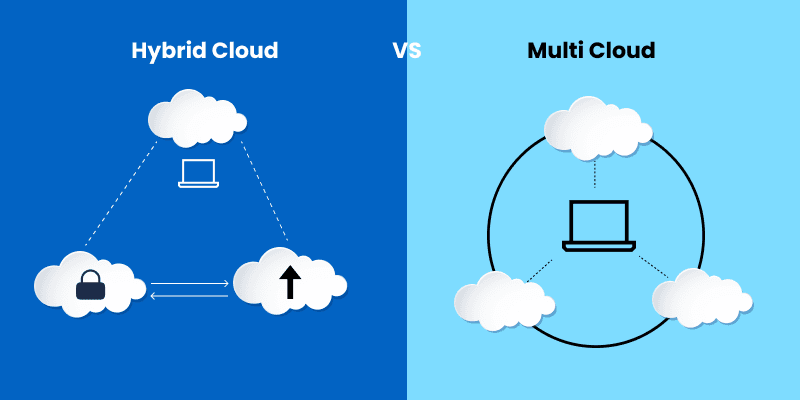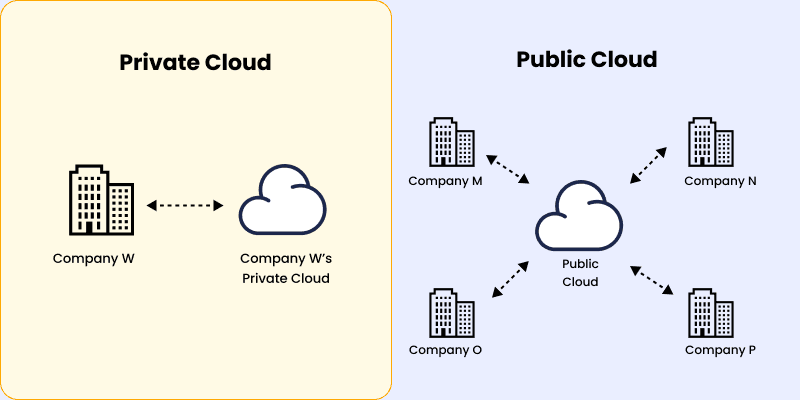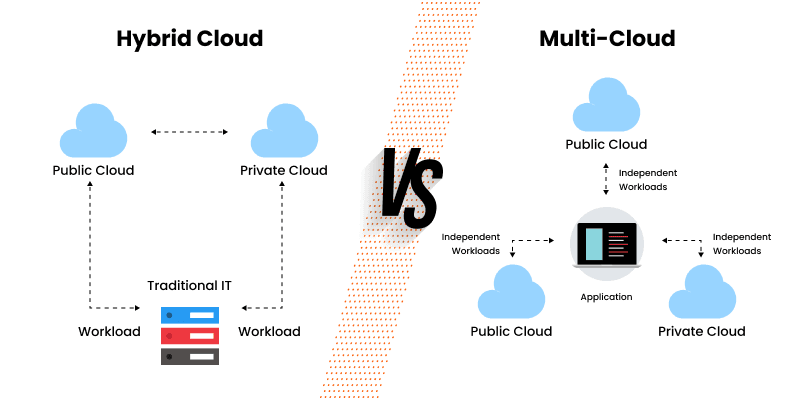Multi-Cloud vs Hybrid Cloud: Full Comparison

Introduction
In today’s digital age, businesses rely heavily on cloud solutions to store data, run applications, and streamline operations. These solutions have revolutionized how organizations function, offering unmatched scalability, flexibility, and efficiency for modern business needs. Two popular cloud strategies are multi-cloud and hybrid cloud. Understanding their differences is crucial to selecting the right option for your business. To begin, it is essential to understand the foundational concepts of public and private clouds.
Public Cloud vs Private Cloud

Before exploring multi-cloud and hybrid cloud strategies, it’s essential to understand the types of cloud environments they rely on:
What is a Public Cloud Solution?
A public cloud is a service provided by third-party vendors, like AWS, Microsoft Azure, or Google Cloud. Resources such as servers, storage, and applications are hosted and managed by the vendor and shared among multiple organizations. This means that different businesses use the same infrastructure, with their data and applications kept separate and secure through virtualization and other technologies. Public cloud solutions are:
- Cost-effective: You pay for only the resources you use.
- Scalable: Easily adjust resources as your needs grow or shrink.
- Accessible: Available from anywhere with an internet connection.
What is a Private Cloud Solution?
A private cloud is dedicated exclusively to one organization. It can be hosted on-premises or by a third-party provider. Private cloud solutions offer:
- Enhanced Security: Resources are isolated, reducing risk.
- Customization: Tailored to meet specific business needs.
- Control: Full oversight of data, applications, and infrastructure.
What is Multi-Cloud?
Multi-cloud refers to the use of multiple public cloud providers simultaneously. Businesses might prefer this approach because it allows them to avoid reliance on a single vendor, leverage specialized services unique to each provider, and enhance resilience by spreading workloads across diverse platforms. For instance, a company might use AWS for hosting applications and Google Cloud for data analytics. The main benefits include:
- Avoiding Vendor Lock-in: Freedom to choose the best services from different providers.
- Optimization: Select the cloud provider that excels in specific tasks or regions.
- Resilience: Reduced downtime risk by spreading workloads across multiple clouds.
What is Hybrid Cloud?
Hybrid cloud combines both public and private clouds, enabling seamless data and application sharing between the two. For example, sensitive customer data could be stored in a private cloud, while non-critical tasks run on a public cloud. Benefits include:
- Flexibility: Tailor the cloud environment to specific workloads.
- Cost Management: Use the public cloud for scalable needs while keeping sensitive operations in-house.
- Integrated Operations: Create a unified ecosystem for diverse IT needs.
Key Differences: Multi-Cloud vs Hybrid Cloud

Here’s how multi-cloud and hybrid cloud differ in various aspects:
Impact of AI and Machine Learning on Multi-Cloud and Hybrid Cloud
AI and machine learning (ML) technologies are transforming how businesses manage cloud environments. By leveraging these advanced tools, organizations can optimize performance, enhance security, and streamline operations.
How AI/ML Enhances Cloud Management
- Predictive Analytics: AI/ML can analyze historical data to predict usage patterns, allowing businesses to allocate resources more effectively.
- Automated Monitoring: These technologies can monitor cloud environments continuously, identifying and resolving issues in real time.
- Workload Optimization: AI-driven tools ensure workloads are distributed efficiently across cloud platforms, minimizing costs and improving performance.
Use Cases
- Resource Forecasting: AI models can anticipate future resource requirements, preventing over-provisioning or underutilization.
- Security Threat Detection: ML algorithms can detect anomalies in cloud traffic, alerting administrators to potential breaches.
- Dynamic Scaling: AI can automatically scale resources up or down based on real-time demands.
The Role of Edge Computing in Multi-Cloud and Hybrid Cloud
Edge computing plays a crucial role in enhancing multi-cloud and hybrid cloud strategies by bringing computation and data storage closer to the source of data generation. This integration reduces latency and improves performance, making it an essential component for modern cloud architectures.
How Edge Computing Integrates with Cloud Environments
- Data Proximity: Edge computing ensures that critical data processing occurs near the data source, reducing the need for frequent transfers to centralized cloud servers.
- Seamless Connectivity: By connecting edge devices to public and private clouds, businesses can create a unified ecosystem.
Benefits of Edge Computing in Multi-Cloud and Hybrid Cloud
- Reduced Latency: Processing data at the edge significantly decreases response times, enhancing user experiences.
- Bandwidth Optimization: Offloading tasks to edge devices reduces the amount of data sent to central clouds, saving bandwidth.
- Improved Reliability: Local processing ensures continued operations even during connectivity disruptions with the central cloud.
How to Choose the Right Cloud Option for Your Business
Choosing the right cloud strategy is a critical decision that can significantly impact your business operations and growth. Here are some factors to consider when deciding between multi-cloud and hybrid cloud:
Business Needs:
- Opt for hybrid cloud if you handle sensitive data that requires enhanced security.
- Choose multi-cloud if you want to leverage best-in-class services from multiple providers.
Budget:
- If cost is a concern, hybrid cloud can reduce expenses by utilizing on-premises infrastructure for critical workloads.
Scalability:
- Multi-cloud is ideal for businesses needing maximum scalability and global reach.
Compliance:
- Hybrid cloud is better for industries with strict regulatory requirements, as it allows sensitive data to stay private.
Management Resources:
- Multi-cloud requires expertise in managing multiple vendors, while hybrid cloud demands effective integration.
Conclusion
Both multi-cloud and hybrid cloud have unique advantages. Multi-cloud is excellent for flexibility and leveraging diverse services, while hybrid cloud offers tight control and integration for sensitive operations. Assess your business goals, data security needs, and budget to make an informed decision.
